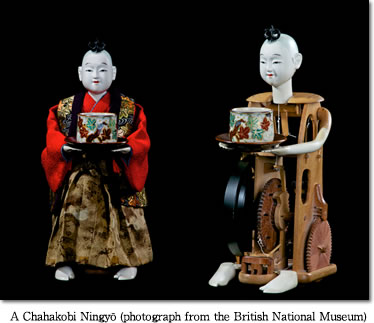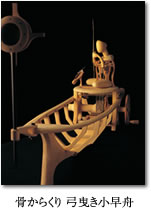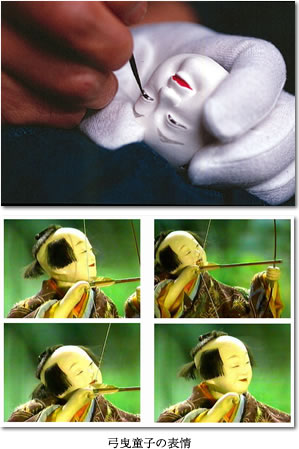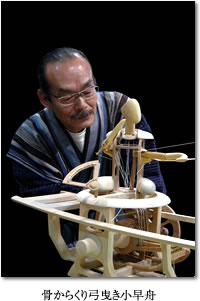
The method for constructing Chahakobi Ningyō is detailed in the first volume of Karakuri-zui. Also known as Chakumi Ningyō, the doll's movements are explained in the notes as follows: “If a tea cup is placed on top of the tray held by the doll, the doll will move to the other side of the room. If the tea cup is taken off the tray, the doll stops moving. When the tea cup is placed on the tray again, the doll turns around and go back to where it came from.” In Nagoya in 1969, the seventh generation Tamaya Shobei succeeded in using the information recorded in the Karakuri-zui to make an exact reproduction of this doll. Aside from the fact that it is made of wood, the mechanisms at work in the Chahakobi Ningyō represent a number of elements that correspond with the principles of modern machinery. Moving automatically to accomplish a set task, this unprecedented doll could be labeled a “wooden robot”.


The Yumihiki Dōji is a type of Zashiki Karakuri doll. “Hisashige Tanaka, the Thomas Edison of Japan, devoted all of his technological skill to the creation of this Karakuri doll. It is his masterpiece. The automata rests on a stand which houses the engine and mechanism which allows it to move. It shoots four arrows in succession at a target placed several meters away. Storing power in a brass spring, the doll's movements are achieved by a string which moves over several different cams. While it is an extremely simple mechanism, the movements of the head, which houses over half of the strings used for movement, are something like the graceful movements of a Noh actor. The doll expresses human movements and gestures remarkably well” (Suzuki, K. Karakuri Ningyō, p. 2).

 In 1998 Shobei Tamaya succeeded in recreating the Yumihiki Dōji according to Hisashige Tanka's original design. In 2009 Tamaya collaborated with designer Shunji Nakayama to create a new generation of Yumihiki Dōji, titled “Hone Karakuri - Yumihiki Kobayabune”.
In 1998 Shobei Tamaya succeeded in recreating the Yumihiki Dōji according to Hisashige Tanka's original design. In 2009 Tamaya collaborated with designer Shunji Nakayama to create a new generation of Yumihiki Dōji, titled “Hone Karakuri - Yumihiki Kobayabune”.
